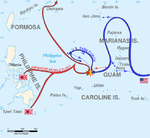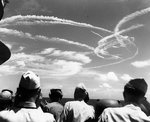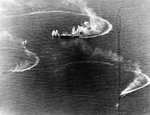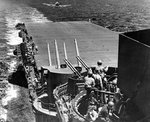syscom3
Pacific Historian
The Battle of the Philippine Sea (aka "The Marianas Turkey Shoot") was a decisive naval battle of World War II, and the largest aircraft carrier battle in history. It was fought between the navies of the United States and the Empire of Japan. Part of the wider Pacific War, this action occurred on June 19–20, 1944 off the Mariana Islands and also involved Japanese land-based aircraft. The engagement proved disastrous for the Imperial Japanese Navy, which lost three aircraft carriers and some 600 aircraft. These losses are largely attributed to the obsolescence of the Japanese aircraft and the inexperience of the Japanese carrier aircrew (many experienced pilots had died during the Guadalcanal campaign and other engagements), in contrast to the U.S. Navy's more modern Grumman F6F Hellcat fighter, its better-trained and more experienced airmen, and its radar-directed combat air patrols.
Background
In September 1943, Imperial Japanese Navy Headquarters decided that the time was right to go back on the offensive in the Pacific. Since the U.S. was attacking Japanese-held islands in the course of its "island hopping campaign", the lack of aircraft could be addressed with the addition of strong land-based air forces. The result was Operation A, which would take place some time in early 1944, attacking the U.S. Pacific Fleet while it launched its next minor offensive. On May 3, orders for Operation A were sent out, and the waiting began.
The Japanese fleet, commanded by Vice-Admiral Jisaburo Ozawa, consisted of five large carriers (Taihō, Shōkaku, Zuikaku, Junyō, and Hiyō), four light carriers (Ryuho, Chitose, Chiyoda, and Zuihō), five battleships (Yamato, Musashi, Kongō, Haruna, and Nagato) and supporting cruisers, destroyers, and oilers.
On June 12, U.S. carriers started a series of air strikes on the Marianas, convincing Admiral Toyoda Soemu, Commander-in-Chief of the Combined Fleet, that the U.S. was preparing to invade. This came as something of a surprise because the Japanese had expected the next U.S. target to be further to the south, either the Carolines or the Palaus, and therefore the Marianas were protected with a weak force of only 50 aircraft.
On June 14, 1944, the U.S. started its invasion of Saipan, and Toyoda gave the order for the attack. The main portions of the fleet, consisting of six carriers and several battleships, rendezvoused on June 16 in the western part of the Philippine Sea, and completed refueling on June 17.
American response
The Japanese forces had been sighted on June 15 by American submarines, and by the next day Admiral Raymond Spruance, commander of the U.S. 5th Fleet, was convinced that a major battle was about to start. By the afternoon of June 18, Vice Admiral Marc Mitscher, aboard his flagship (the carrier USS Lexington) had his Task Force 58 (the Fast Carrier Task Force) formed up near Saipan to meet the Japanese attack.
TF-58 consisted of five major groups. In front (to the west) was Vice Admiral Willis Lee's Task Group 58.7 (TG-58.7), the "Battle Line", consisting of seven fast battleships (Washington, North Carolina, Indiana, Iowa, New Jersey, South Dakota, and Alabama). Just north of them was the weakest of the carrier groups, Rear Admiral William K. Harrill's TG-58.4 of three carriers (Essex, Langley, and Cowpens). To the east, in a line running north to south, were three groups each containing four carriers: Rear Admiral Joseph Clark's TG-58.1 (Hornet, Yorktown, Belleau Wood, and Bataan); Rear Admiral Alfred Montgomery's TG-58.2 (Bunker Hill, Wasp, Cabot, and Monterey); and Rear Admiral John W. Reeves's TG-58.3 (Enterprise, Lexington, San Jacinto, and Princeton). The capital ships were supported by eight heavy cruisers, 13 light cruisers, 58 destroyers, and 28 submarines.
Shortly before midnight on June 18, Admiral Chester W. Nimitz sent Spruance a message from Pacific Fleet Headquarters indicating that the Japanese flagship was approximately 350 miles (562 km) to the west-southwest of Task Force 58. This was based on a "fix" obtained by radio direction-finding.
Mitscher realized that if Task Force 58 were to advance westwards there was a strong chance of a night surface encounter with Ozawa's forces. He therefore conferred with Lee, commander of the Fifth Fleet Battle Line, and enquired whether Lee favored such an encounter. The battleship commander was not enthusiastic about a night engagement with Japanese surface forces, despite his new ships outclassing most of the Japanese battleships, feeling that his crews were not adequately trained for such an action. Shortly after his discussion with Lee, Mitscher asked Spruance for permission to head west during the night to reach what would be an ideal launch position for an all-out aerial assault on the enemy force at dawn.
However, Spruance refused. Throughout the run-up to the battle he had been concerned that the Japanese would try to draw his main fleet away from the landing area using a diversionary force, and would then make an attack around the flank of the U.S. carrier force — an "end run" — hitting the invasion shipping off Saipan. He was therefore not prepared to let Task Force 58 be drawn westwards, away from the amphibious forces.
Spruance was conscious that Japanese operational plans frequently relied heavily on the use of decoying, diversionary forces. Ironically, however, on this occasion there was no such aspect to the Japanese plan. There was no ruse, no diversionary force.
Spruance was heavily criticized by many officers after the battle, and continues to be to this day, because he allegedly missed the chance to destroy all of the Japanese strike force, but it is instructive to compare Spruance's caution with Admiral "Bull" Halsey's later impetuous pursuit of a diversionary force of Japanese carriers at the Battle of Leyte Gulf that left inferior U.S. forces open to attack off Samar by a Japanese surface action group composed of cruisers, destroyers and battleships.
Battle
Early actions
At 05:30 on June 19, TF-58 turned northeast into the wind and started to launch their air patrols. The Japanese had already launched their morning search patrols using some of the 50 aircraft stationed on Guam, and at 05:50, one of these, a Mitsubishi Zero, found TF-58. After radioing his sighting of U.S. ships, he attacked one of the destroyers on picket duty and was shot down.
Thus alerted, the rest of the Guam forces began forming up for an attack, but were spotted on radar by U.S. ships, and a group of F6F Hellcats from the Belleau Wood were sent to investigate. The Hellcats arrived while aircraft were still launching from Orote Field. Minutes later, additional radar contacts were seen, which were later discovered to be the additional forces being sent north from the other islands. A huge battle broke out; 35 of the Japanese planes were shot down, and the battle was still going an hour later when the Hellcats were recalled to their carriers.
Background
In September 1943, Imperial Japanese Navy Headquarters decided that the time was right to go back on the offensive in the Pacific. Since the U.S. was attacking Japanese-held islands in the course of its "island hopping campaign", the lack of aircraft could be addressed with the addition of strong land-based air forces. The result was Operation A, which would take place some time in early 1944, attacking the U.S. Pacific Fleet while it launched its next minor offensive. On May 3, orders for Operation A were sent out, and the waiting began.
The Japanese fleet, commanded by Vice-Admiral Jisaburo Ozawa, consisted of five large carriers (Taihō, Shōkaku, Zuikaku, Junyō, and Hiyō), four light carriers (Ryuho, Chitose, Chiyoda, and Zuihō), five battleships (Yamato, Musashi, Kongō, Haruna, and Nagato) and supporting cruisers, destroyers, and oilers.
On June 12, U.S. carriers started a series of air strikes on the Marianas, convincing Admiral Toyoda Soemu, Commander-in-Chief of the Combined Fleet, that the U.S. was preparing to invade. This came as something of a surprise because the Japanese had expected the next U.S. target to be further to the south, either the Carolines or the Palaus, and therefore the Marianas were protected with a weak force of only 50 aircraft.
On June 14, 1944, the U.S. started its invasion of Saipan, and Toyoda gave the order for the attack. The main portions of the fleet, consisting of six carriers and several battleships, rendezvoused on June 16 in the western part of the Philippine Sea, and completed refueling on June 17.
American response
The Japanese forces had been sighted on June 15 by American submarines, and by the next day Admiral Raymond Spruance, commander of the U.S. 5th Fleet, was convinced that a major battle was about to start. By the afternoon of June 18, Vice Admiral Marc Mitscher, aboard his flagship (the carrier USS Lexington) had his Task Force 58 (the Fast Carrier Task Force) formed up near Saipan to meet the Japanese attack.
TF-58 consisted of five major groups. In front (to the west) was Vice Admiral Willis Lee's Task Group 58.7 (TG-58.7), the "Battle Line", consisting of seven fast battleships (Washington, North Carolina, Indiana, Iowa, New Jersey, South Dakota, and Alabama). Just north of them was the weakest of the carrier groups, Rear Admiral William K. Harrill's TG-58.4 of three carriers (Essex, Langley, and Cowpens). To the east, in a line running north to south, were three groups each containing four carriers: Rear Admiral Joseph Clark's TG-58.1 (Hornet, Yorktown, Belleau Wood, and Bataan); Rear Admiral Alfred Montgomery's TG-58.2 (Bunker Hill, Wasp, Cabot, and Monterey); and Rear Admiral John W. Reeves's TG-58.3 (Enterprise, Lexington, San Jacinto, and Princeton). The capital ships were supported by eight heavy cruisers, 13 light cruisers, 58 destroyers, and 28 submarines.
Shortly before midnight on June 18, Admiral Chester W. Nimitz sent Spruance a message from Pacific Fleet Headquarters indicating that the Japanese flagship was approximately 350 miles (562 km) to the west-southwest of Task Force 58. This was based on a "fix" obtained by radio direction-finding.
Mitscher realized that if Task Force 58 were to advance westwards there was a strong chance of a night surface encounter with Ozawa's forces. He therefore conferred with Lee, commander of the Fifth Fleet Battle Line, and enquired whether Lee favored such an encounter. The battleship commander was not enthusiastic about a night engagement with Japanese surface forces, despite his new ships outclassing most of the Japanese battleships, feeling that his crews were not adequately trained for such an action. Shortly after his discussion with Lee, Mitscher asked Spruance for permission to head west during the night to reach what would be an ideal launch position for an all-out aerial assault on the enemy force at dawn.
However, Spruance refused. Throughout the run-up to the battle he had been concerned that the Japanese would try to draw his main fleet away from the landing area using a diversionary force, and would then make an attack around the flank of the U.S. carrier force — an "end run" — hitting the invasion shipping off Saipan. He was therefore not prepared to let Task Force 58 be drawn westwards, away from the amphibious forces.
Spruance was conscious that Japanese operational plans frequently relied heavily on the use of decoying, diversionary forces. Ironically, however, on this occasion there was no such aspect to the Japanese plan. There was no ruse, no diversionary force.
Spruance was heavily criticized by many officers after the battle, and continues to be to this day, because he allegedly missed the chance to destroy all of the Japanese strike force, but it is instructive to compare Spruance's caution with Admiral "Bull" Halsey's later impetuous pursuit of a diversionary force of Japanese carriers at the Battle of Leyte Gulf that left inferior U.S. forces open to attack off Samar by a Japanese surface action group composed of cruisers, destroyers and battleships.
Battle
Early actions
At 05:30 on June 19, TF-58 turned northeast into the wind and started to launch their air patrols. The Japanese had already launched their morning search patrols using some of the 50 aircraft stationed on Guam, and at 05:50, one of these, a Mitsubishi Zero, found TF-58. After radioing his sighting of U.S. ships, he attacked one of the destroyers on picket duty and was shot down.
Thus alerted, the rest of the Guam forces began forming up for an attack, but were spotted on radar by U.S. ships, and a group of F6F Hellcats from the Belleau Wood were sent to investigate. The Hellcats arrived while aircraft were still launching from Orote Field. Minutes later, additional radar contacts were seen, which were later discovered to be the additional forces being sent north from the other islands. A huge battle broke out; 35 of the Japanese planes were shot down, and the battle was still going an hour later when the Hellcats were recalled to their carriers.
Attachments
Last edited:




